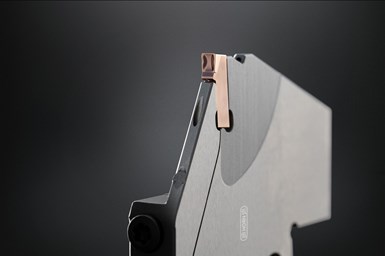Horn EH Geometry for Grooving System Enables Parting Off at High Feed Rates
The stable cutting edge of the EH geometry ensures reliable chip evacuation and control.

The EH geometry ensures reliable chip evacuation and control.
Horn’s EH geometry for its S100 grooving system enables parting off at high feed rates. The stable cutting edge enables feed rates in the range of f= 0.25-0.4 mm/rev during grooving and parting off, which results in reduced machining time across multiple operations.
The company says that reliable chip evacuation and control is ensured by a special chip formation. High feed rates require a stable machine when grooving and parting off, as well as secure clamping of the workpiece. Starting from a feed rate of 0.3 mm/rev (0.012" /rev), Horn recommends reducing the infeed for the first 3-4 mm (0.118"- 0.157") during grooving and parting off. Due to their stability, holders and cassettes are often the first choice when grooving along the Y axis. Horn offers the single-edged grooving inserts in widths of 3 mm (0.118") and 4 mm (0.157").
In 2019, Horn expanded the S100 grooving system by adding new holder variants for grooving on turn-mill centers with the feed along the Y axis. The process enables high-performance parting off with high cutting values, resulting in a shorter machining time. These holder variants offer the ability to part off large diameters using a compact holder as well as parting off with narrower widths.
Substantial cutting forces are generated while parting off large diameter workpieces. The available space inside machines often does not allow the use of large cross-section tools. The toolholder’s new insert arrangement enables the cutting forces to be absorbed by the main cross section of the part-off tool. This results in higher rigidity of the overall system for a given cross section, enabling higher feed rates for the width of insert. The transmission of force along the longitudinal direction of the tool enables narrower holders to be used to achieve the same system rigidity.
Related Content
-
Data Matrix Codes Offer Cutting Tool Traceability
A company’s quest to discover errors in a manufacturing process has led to printing data matrix codes on its cutting tools that provide a wealth of information for both the user and this cutting tool manufacturer.
-
Shop Sets its Sights on Precise Tool Alignment
A Wisconsin shop has found that visual tool alignment technology has improved tool life and surface finishes for its Swiss-type lathes while increasing throughput as well.
-
The Value of Tool Monitoring on Rotary Transfer Machines
By using a tool monitoring system, shops can save costs associated with machine maintenance and downtime for tool changes while increasing cutting performance.







.png;maxWidth=300;quality=90)





